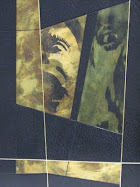The posts under these headings, are not intended as detailed instructions, but more as an overview of the work experience at PDB in the the first 4 years of its operation.Thats not to say there won't be detail, just don't look for it.Nor are they intended to be final, as I hope to add as I go on.
 One of the first things you learn as a bookbinder is the simple, versatile and ever ubiquitous casebinding.You may learn the full, 1/4, and half cases, if you are lucky enough to work in a trade bindery you may even learn how to make a living at it.You will probably be taught how to sew sections, maybe even a different endpaper to the simple codex, but what you won't learn..........is how to bind single sheets.
One of the first things you learn as a bookbinder is the simple, versatile and ever ubiquitous casebinding.You may learn the full, 1/4, and half cases, if you are lucky enough to work in a trade bindery you may even learn how to make a living at it.You will probably be taught how to sew sections, maybe even a different endpaper to the simple codex, but what you won't learn..........is how to bind single sheets.If you can't find a way to deal with single sheets, you will starve!The method we use has not changed since Arthur Johnson detailed it in his manual.You will not always get sections(very rarely),so you have to know when to stab-sew, and when to overcast.The right sewing in combination with the right paper can produce good results.Recent developments in graphic applications have made it easier for pagination in sections, but the limited size of digital printers means this will remain a problem for the foreseeable future.
In making cases it is imperative to remember what I will now refer to as "Arthur Johnson's Golden Rule"..which came in the form of a question he was fond of catching people out on:
 "What are endpapers for?"...a simple enough question for the young case binder, who replying with gusto would retort "well, they keep the book in the case", belying his limited understanding.
"What are endpapers for?"...a simple enough question for the young case binder, who replying with gusto would retort "well, they keep the book in the case", belying his limited understanding.The answer to this most basic of all questions unlocks a fundamental understanding at the core of bookbinding.
"NO! they are to counteract the warp of the boards"...i guess there was more to binding than cases!
This basic knowledge is seen at work in casebinding.If you want to glue out with a paste/pva mix, giving you time to do the other side and nip in the stack, you must make the cases using the same adhesive, or the resulting warp will demonstrate the lack of balance!
I have learned that at the Wyvern Bindery , and at Blissett's both in london, an experienced casebinder can make 25 cases an hour , and case-in a book every 30 - 60 seconds(thanks Nick!).Multiply that by what you may charge, and ask yourself is there a more cost effective, and profitable item a bookbinder can produce.Now no one here is suggesting you should aspire to make casebindings for the rest of your life, but knowing how to do them, and do them efficiently, could save your life....or at the very least pay a few months rent!

Pictured, is a recent 3-piece, split-board case binding I completed for architect Santiago Calatrava.The size and weight of the paper all lend it self well to stab-sewing, ensuring a strong binding, some throw-up, but pleasant enough due to the landscape format.









1 comment:
The architecture book is beautiful! And, while I don't do lots of case binding myself, you've inspired me to go back in to that side of things and remind my hands how to do it really well - thanks!
Post a Comment